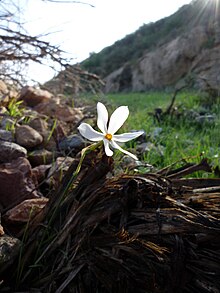You can help expand this article with text translated from the corresponding article in Spanish. (November 2014) Click for important translation instructions.
|
| Narcissus serotinus | |
|---|---|

| |
| Scientific classification | |
| Kingdom: | Plantae |
| Clade: | Tracheophytes |
| Clade: | Angiosperms |
| Clade: | Monocots |
| Order: | Asparagales |
| Family: | Amaryllidaceae |
| Subfamily: | Amaryllidoideae |
| Genus: | Narcissus |
| Species: | N. serotinus |
| Binomial name | |
| Narcissus serotinus L. | |
| Synonyms | |
| |

Narcissus serotinus is a autumn-flowering species of the genus Narcissus (daffodils) in the family Amaryllidaceae. It is classified in Section Serotini. It is native to Portugal, Spain, and Morocco. Records further east in the Mediterranean refer to Narcissus obsoletus and Narcissus elegans.
Description
Narcissus serotinus has one of the smallest coronas of the genus (see illustration). The flowers are fragrant, the tepals white and the small corona yellow.
References
- The Plant List
- Sp. Pl. 290 1753.
- "Narcissus serotinus L." Plants of the World Online. Royal Botanic Gardens, Kew. Retrieved 21 January 2024.
- Díaz Lifante, Z.; Camacho, C.A. (2007). "Morphological variation of Narcissus serotinus L. s.l. (Amaryllidaceae) in the Iberian Peninsula". Botanical Journal of the Linnean Society. 154 (2): 237–257. doi:10.1111/j.1095-8339.2007.00653.x.
- Díaz Lifante, Z.; Camacho, C.A.; Viruel, J.; Cabrera Caballero, A. (2009). "The allopolyploid origin of Narcissus obsoletus (Alliaceae): identification of parental genomes by karyotype characterization and genomic in situ hybridization". Botanical Journal of the Linnean Society. 159: 477–498. doi:10.1111/j.1095-8339.2009.00951.x.
| Taxon identifiers | |
|---|---|
| Narcissus serotinus |
|
This Amaryllidaceae article is a stub. You can help Misplaced Pages by expanding it. |